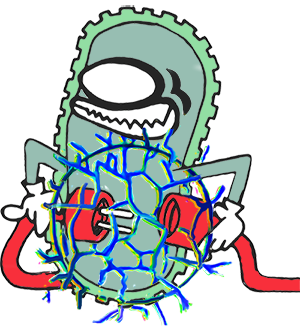Team:TU Delft-Leiden/Project/Life science/curli/characterisation
From 2014.igem.org
| Line 171: | Line 171: | ||
<figure> | <figure> | ||
<img style="float: left;margin-right: 5px; "src="https://static.igem.org/mediawiki/2014/0/0d/Resistance_measurement.jpg" width="40%" height="40%"> | <img style="float: left;margin-right: 5px; "src="https://static.igem.org/mediawiki/2014/0/0d/Resistance_measurement.jpg" width="40%" height="40%"> | ||
| - | <img style="float: right;"src="https://static.igem.org/mediawiki/2014/3/3e/Dropsens_Gold_electrodes.jpg" width="40%" height="40"> | + | <img style="float: right;"src="https://static.igem.org/mediawiki/2014/3/3e/Dropsens_Gold_electrodes.jpg" width="40%" height="40%"> |
<p> | <p> | ||
Revision as of 11:20, 17 October 2014
Module Conductive Curli – Characterization
Plate Reader
A plate reader is a machine designed to handle samples on 6-1536 well format microtiter plates for the measuring of physical properties such as absorbance, fluorescence intensity, luminescence, time-resolved fluorescence, and fluorescence polarisation.
The different constructs used are: p[rham]-CsgB – p[const.]–CsgA, also referred here as CC50, p[rham]-CsgB – p[const.]–CsgA:HIS, also referred here as CC51, p[rham]-CsgB-CsgA, also referred here as CC52, p[const.]-eGFP, also referred here as CC54
In this module, the cells carrying the curli-forming BioBricks (CC50 (P[RHAM]-CSGB – P[CONST.]–CSGA), CC51 (P[RHAM]-CSGB – P[CONST.]–CSGA:HIS),or CC52 (P[RHAM]-CSGB-CSGA)) also carried a plasmid constitutively expressing eGFP (CC54 (P[CONST.]-EGFP)). Hence, an assay to detect biofilm formation (due to the curli) can be performed. The cells can be grown on a 96-well plate, where curli formation will be induced with Rhamnose. The cells carrying CC50 (P[RHAM]-CSGB – P[CONST.]–CSGA), CC51 (P[RHAM]-CSGB – P[CONST.]–CSGA:HIS),or CC52 (P[RHAM]-CSGB-CSGA) together with CC54 (P[CONST.]-EGFP) will generate curli under these conditions, whereas the cells carrying CC54 (P[CONST.]-EGFP) alone will not. Under the Plate reader, the wells can be analysed for green fluorescence. Before washing out the cells all wells carrying cells with CC54 (P[CONST.]-EGFP) should present green fluorescence. After washing out the cells, however, only the wells carrying cells with CC54 (P[CONST.]-EGFP) together with one of the curli-forming BioBricks should still generate green fluorescence, because the curli would have made these cells attach to the walls of the wells and not being washed out. The final protocol developed for Plate reader analysis for this module can be found by clicking on this link .
Results - Plate Reader

Figure 1 shows the OD of the cells after two rounds of washing them out of the 96-well plate. On the image it can be appreciated that the cells carrying the curli-forming BioBricks (CC50 (P[RHAM]-CSGB – P[CONST.]–CSGA)+CC54 (P[CONST.]-EGFP), CC51 (P[RHAM]-CSGB – P[CONST.]–CSGA:HIS)+CC54 (P[CONST.]-EGFP) and CC52 (P[RHAM]-CSGB-CSGA)+CC54 (P[CONST.]-EGFP)) retain many more cells when they are induced with Rhamnose, whereas no noticeable increase of the OD is oserved under induction for the cells that do not carry curli-forming constructs (CC54 (P[CONST.]-EGFP) alone and empty cell). This suggests that cell retention happens when the curli genes are expressed.
Confocal Microscopy
Confocal microscopy is an imaging technique that allows for the visualisation of fluorescent bodies with higher resolution and improved contrast compared to Bright-field microscopy. Whereas fluorescent Bright-field microscopes excite all the sample analysed, confocal microscopes can highly reduce the excited field, thus eliminating the background noise produced by species neighbouring the body of interest.
We used confocal microscpoy technology to observe the deposition of cells at the bottom of the microscope slide. Figures 2-6 intend to represent how after induction with Rhamnose the cells forming curli are attached faster to the surface (bottom) of the microscope slide than when they are not induced.
The fact that more cells are observed at the bottom for the ones carrying the CC54 (P[CONST.]-EGFP) plasmid alone, or the empty cells is attributed to the fact that these cells grow faster because they do not have the burden of carrying an extra plasmid, or even two in the case of the empy cells. This idea is supported by the fact that the induction of the curli-forming genes clearly indicates a faster deposition of the cells onto the surface of the microscope slide.










Congo Red Assay
We did a Congo Red assay on the following cell cultures: CC54 (P[CONST.]-EGFP) + CC52 (P[RHAM]-CSGB-CSGA), CC54 (P[CONST.]-EGFP) + CC50 (P[RHAM]-CSGB – P[CONST.]–CSGA), CC54 (P[CONST.]-EGFP) + CC51 (P[RHAM]-CSGB – P[CONST.]–CSGA:HIS) and the used strain without plasmid. The protocol that was used for the assay can be found here. We took samples spread over two days and did the following for each sample: First measured the OD600 to be able to correct for growth. Then added Congo Red, waited for five minutes and measured the OD480. If curli (biofilm) is formed, the Congo Red dye will get stuck in the curli biofilm and therefore will be stuck in the pellet after centrifugation. Of course the difference between the non-induced cultures and the induced cultures are the most important, therefore the comparison between the induced and non-induced samples. The results of our assay can be found in figure 7.

In figure 7 we can see that the samples with induced CC50 (P[RHAM]-CSGB – P[CONST.]–CSGA), CC51 (P[RHAM]-CSGB – P[CONST.]–CSGA:HIS) and CC52 (P[RHAM]-CSGB-CSGA) result in a higher value than the non-induced samples, meaning that the OD480 values are more negative (as we measured these in negative values). From this we can deduct that more Congo Red dye got stuck in the pellet in the CC50 (P[RHAM]-CSGB – P[CONST.]–CSGA) induced, CC51 (P[RHAM]-CSGB – P[CONST.]–CSGA:HIS) induced and CC52 (P[RHAM]-CSGB-CSGA) induced cultures and therefore more biofilm was formed. The negative control of empty cells gives roughly the same value for induced as for non-induced cells, which
Conclusions
From the assays performed it can be concluded that:


 "
"






